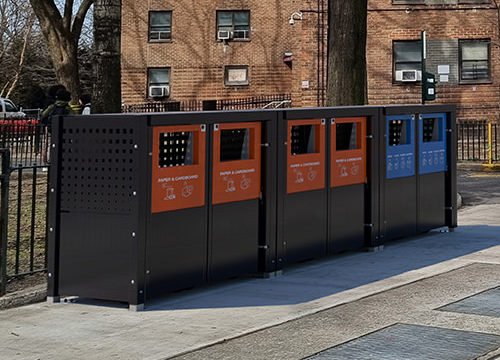
Curbside collection

Accessible trash and recycling containerization systems from metroSTOR can be relied on to improve the streetscape and reduce associated public health issues without driving up collection costs. Consistent highly visible colors, symbols and multi-lingual messaging make streetside waste diversion initiatives easier to implement, reducing contamination and illegal dumping.
Looking in more detail through the metroSTOR 5C prism there are a number of factors to consider when developing strategies to increase waste diversion from curbside collections:
Curbside Collection Capacity
As cart-based collection systems become the norm for effective recycling capture, on-street trash and recycling hubs are increasingly becoming a necessity for the households in densely developed neighbourhoods and city business districts that don’t have space to store multiple carts, whether this be single or twin-stream system. Most cities allow 35 gallons trash per week for a household with 1–2-people, 65 gallons for a 2-4-people and 96 gallons for 4+ people, with the same volume again for recycling. metroSTOR Waste & Recycling Housings take up as little of the sidewalk as possible and enable collection streams to change in the future if required. Options are available for access control to exclude unauthorized users.
Curbside Collection Convenience
Successful waste diversion strategies for curbside collection need deposit points for trash and regular recyclables located within 40-60yds of each household. The best results are obtained when they are located in well-lit areas, with each stream being readily identifiable at a glance and designed so that the carts can be accessed easily without having to unlock and open doors, touch lids or lift trash bags over an excessively high cill.
Curbside Collection Communication
Recycling streams are most clearly identifiable when recognizable color-coding and symbols are used to define acceptable materials, alongside restricted apertures to minimize contamination. With RecycleRight color-coded graphic systems it is recommended that text-only signage is avoided due to communication challenges within multi-lingual communities. metroSTOR B,F and R-Series Housings enable clear communication to be achieved sensitively in a street environment by integrating this into the unit design.so that it’s always visible as users approach. Information on the closest receptor points for non-accepted items along with penalties for non-compliance helps reduce illegal dumping.
Curbside Collection Consistency
Curbside recycling hubs should sit comfortably within the street scene but be instantly recognizable and inviting to users. RecycleRight enables consistent color-coding, symbols and messaging to be used across all city communications, minimizing confusion with users and consequent contamination. metroSTOR Waste & Recycling Housings come in many different module sizes to accommodate commonly used carts and dumpsters, avoiding additional expenditure on infrastructure wherever possible.
Curbside Collection Cleanliness
Containerization is critical to safe, clean streets, free from litter and vermin, but if carts and dumpsters cannot be stored off the street and sidewalk, they need to be secured within an enclosure system to prevent wind-blown litter and reduce illegal dumping. metroSTOR Waste & Recycling Housings improve the street scene visually, reducing both the likelihood and potential impacts of arson, with the added benefit of reduce user-contact with the cart or dumpster, which is especially important for carts containing food scraps or yard waste.
Find out more about metroSTOR product systems for curbside collections or contact our team for a metroSTOR Zero-Waste Pathway consultation.